The winner – GetResponse
Life-changing superhero
In this comparison, Getresponse wins eight out of eleven rounds. Two rounds end in a tie, and there is only one aspect where tinyEmail outperforms GetResponse. Continue reading to learn more.
What GetResponse features are better than tinyEmail?
- Marketing automation features
- Campaign analytics
- Compatibility with other marketing channels
- More integrations
- AI assistance
- Marketing automation options are basic
- Fewer analytics offered
- Only email channel available
- Less integrations, mainly focused on Shopify users
- The AI tool is specifically dedicated to Shopify businesses
tinyEmail and GetResponse are both sufficient email marketing automation platforms. So, if you’re considering either of these tools, then you’re making a good choice.
These platforms, however, have differences in the services they provide and the extent of their capabilities. Therefore, one may be more suitable for your business needs than the other.
In this tinyEmail vs GetResponse comparison, we’ll discuss each tool’s features, functionalities, and prices. We’ll compare them side by side so you can decide which platform suits your business best.
Let’s get started.
tinyEmail vs GetResponse: Quick overview
GetResponse is best known for its ease of use, robust email automation, and ecommerce functionalities.
Founded in 2021, tinyEmail is a newer email marketing platform with a minimalistic interface and simple features. It’s known for its affordability and ease of use.
Both tools offer intuitive email campaign builders, beautiful newsletter templates, and multiple integration options. This includes seamless integrations with top ecommerce platforms like WooCommerce and Shopify.
Here’s a quick comparison table showing each tool’s features side by side.
From the above table, tinyEmail has fewer features compared to GetResponse. This next section of the tinyEmail vs GetResponse discusses these features in more detail.
tinyEmail vs GetResponse comparison: Feature by feature
Here, we’ll compare each of the above-mentioned features to help you understand what each platform offers. We’ll then choose a winner for each feature comparison.
Here you go.
Ease of getting started
Which platform is easier to get started on: GetResponse or tinyEmail?
tinyEmail requires you to fill in more details compared to most other tools during signup. This includes uploading your logo, choosing brand colors, your credit card details, and business and personal information.
We also found it quite unusual that users are required to provide their credit card details even though there’s a free plan.
This makes GetResponse easier to sign up for as they ask fewer questions and don’t ask you to provide your credit card details until you opt for a paid plan.
During setup, tinyEmail doesn’t give you the option to pick the free plan. What happens instead is that after you’ve gone through the initial process, the platform sends you an email later allowing you to sign up without providing your credit card details.
We found this to be a bit confusing.
Other than the initial signup confusion with tinyEmail’s signup process, everything else about the setup is extremely easy, just like with GetResponse. Both platforms have well-designed, intuitive interfaces.
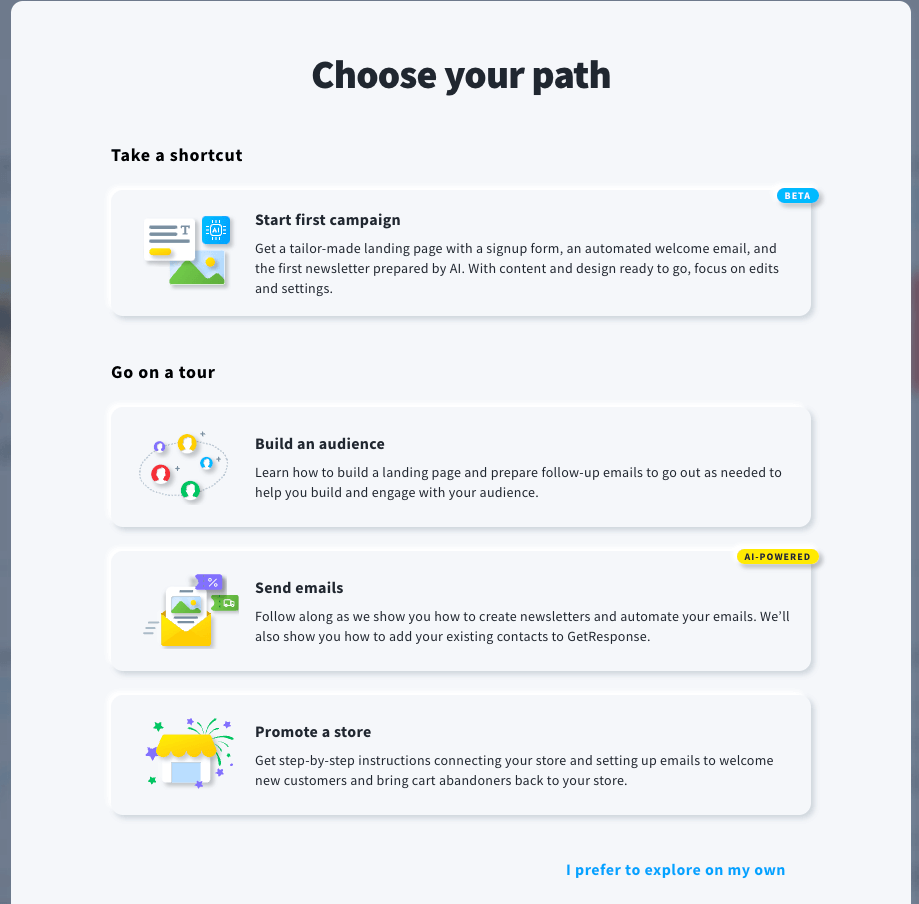
GetResponse Getting started wizard
The menu items are easy to locate, usability is straightforward, and you can easily perform functions like changing the sender’s email address, account verification, etc.
GetResponse wins. The fact that tinyEmail asks for users’ credit card details during signup adds a layer of complication to the signup process.
Building an email campaign
Designing an email campaign on tinyEmail and GetResponse is easy as both builders are pretty intuitive.
Take content blocks for example. Besides the standard blocks like images, text, videos, and social sharing, you get additional useful content blocks for even more functionality.
With tinyEmail, here are a few interactive content blocks you’ll get that aren’t available on GetResponse.
- Countdown timers to add an element of urgency to your campaigns
- Interactive carousels to display multiple products in a single row
- Surveys and polls to capture customer input and feedback
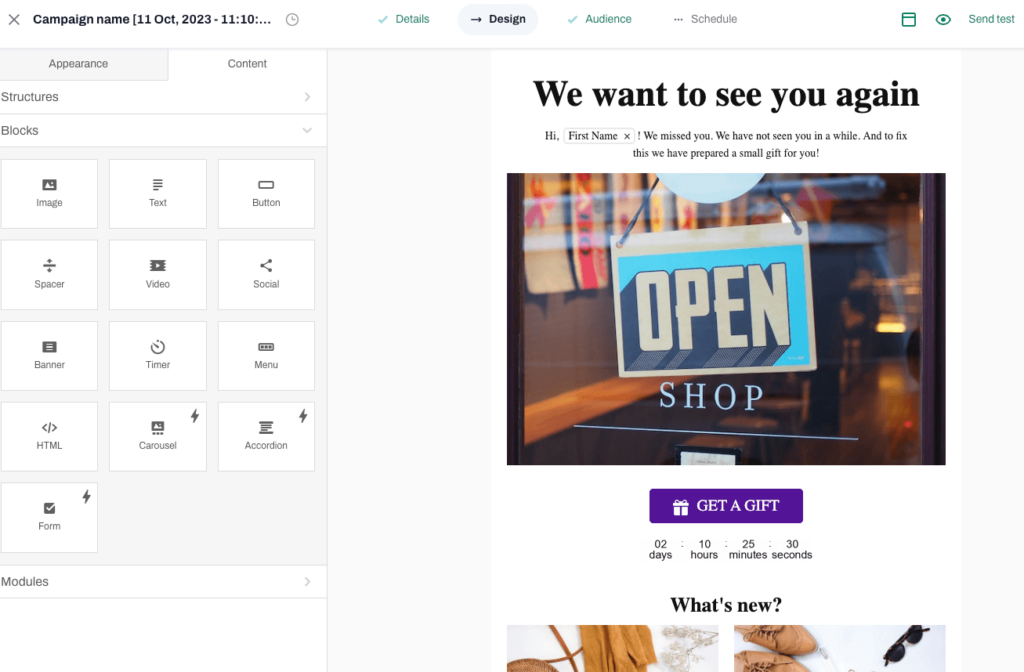
tinyEmail Email builder
GetResponse has a few unique content blocks, which aren’t available on tinyEmail, that are built specifically for ecommerce users. However, these are only available on select higher-tier plans. Here’s a brief description of each:
- The product element block that allows you to pull products (with their descriptions and prices) from your online store into your email body
- The product recommendation block to help you personalize your campaigns
- Unique and generic coupon codes to offer incentives to customers
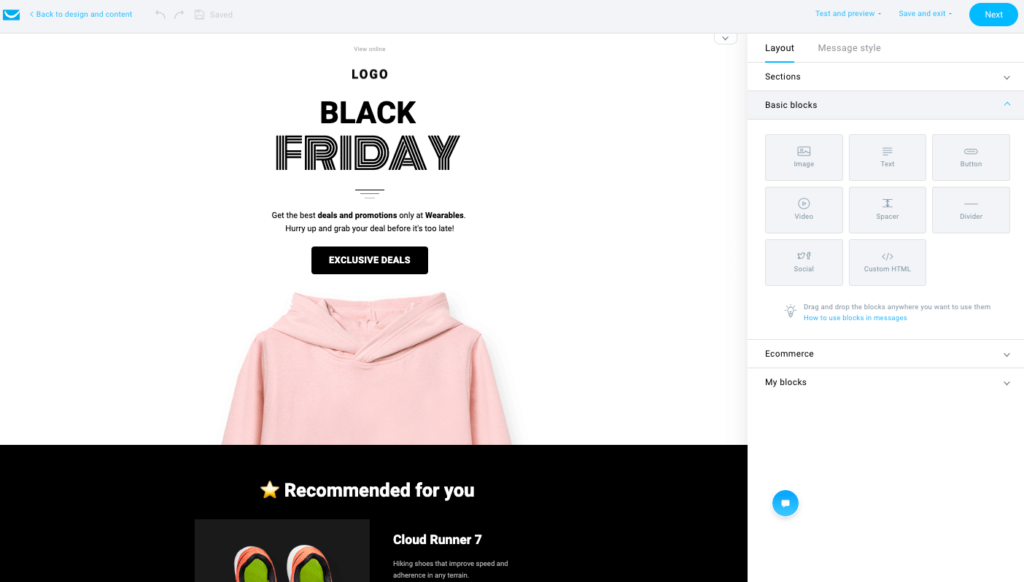
GetResponse Email builder
Next, let’s talk about their prebuilt email templates.
Both platforms offer an extensive list of professionally designed email templates for different occasions. tinyEmail offers 300+ templates, while GetResponse provides over 200 templates.
However, some of tinyEmail’s templates don’t adjust to your brand image automatically, while others do.
Both tools allow you to save content blocks or messages to use later. They also provide the option to add stock images and other visuals to your designs.
tinyEmail comes ready with an entire image studio while GetResponse allows you to import images for free from Shutterstock.
Unlike tinyEmail, GetResponse allows you to send all kinds of emails including regular campaigns, autoresponders, A/B tests, and RSS campaigns. tinyEmail lacks the RSS and a/b test campaign features.
You can easily personalize your email content, preheaders, and subject lines on GetResponse. With tinyEmail, personalization is only available for content and there are no merge-tag buttons for preheaders or subject lines.
GetResponse wins. While both campaign builders are intuitive, GetResponse is more robust overall.
Marketing automation
GetResponse’s marketing automation feature is pretty advanced compared to what tinyEmail offers. It provides almost 43 prebuilt email workflows for different ecommerce use cases.
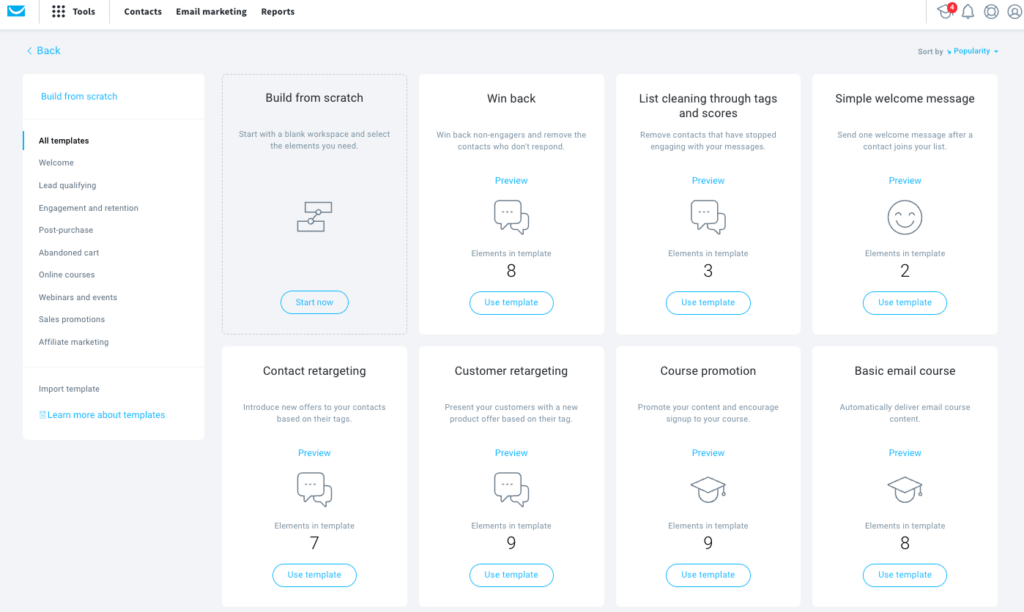
GetResponse automation
These are ready to go with both copy and logic, and you can customize them to fit your needs or build new workflows entirely. This is unlike what we found on tinyEmail.
tinyEmail provides a few automation workflows that are ready-to-go, but most of them (except for the welcome series) only work with Shopify stores.
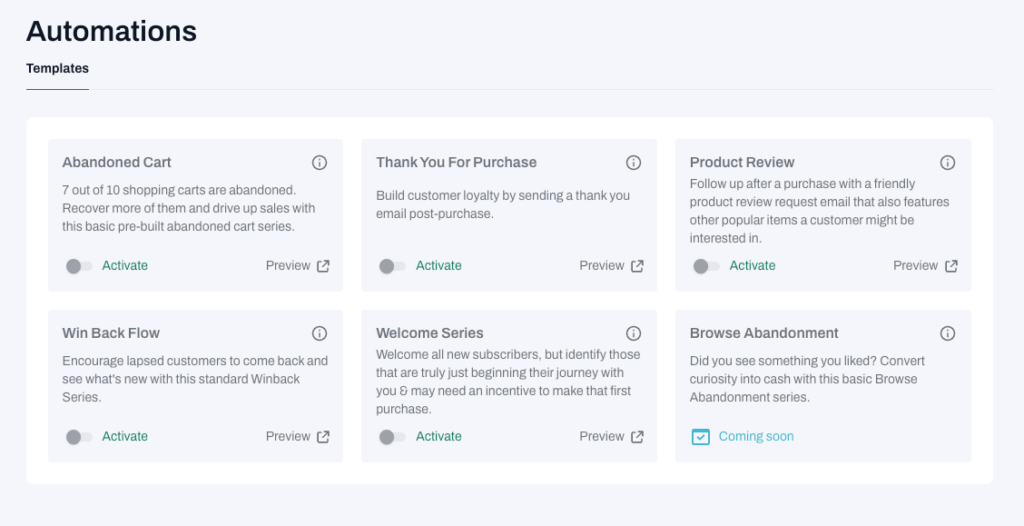
tinyEmail automations
There’s no option to edit these workflows either, and the most you can do is activate them. We found this to be quite limiting.
As mentioned, GetResponse’s automation feature is quite robust. It provides lots of conditions and tags, such as:
- Onsite behavior
- Customer purchases
- Email activity
- Personal details
GetResponse also offers push notifications, unlike tinyEmail, which doesn’t integrate with any other marketing channels.

GetResponse automation builder
The only downside to GetResponse’s automation feature is that the abandoned cart triggers and product recommendations are only available for higher-tier plans.
GetResponse is the winner. While tinyEmail’s automation feature may be enough for small businesses, it’s limited in functionality compared to GetResponse.
Signup forms and landing pages
GetResponse vs tinyEmail: which offers better list-building features?
Let’s find out.
First, we’ll look at their sign-up form options.
Both tinyEmail and GetResponse provide modern-looking signup form templates. You can display them as popups, embedded forms, flyouts, etc.
Overall, we found GetResponse’s form options to be pretty robust compared to tinyEmail. For instance, unlike tinyEmail, GetResponse provides over 30 triggering rules for popups to help you catch visitors when they’re most likely to convert.
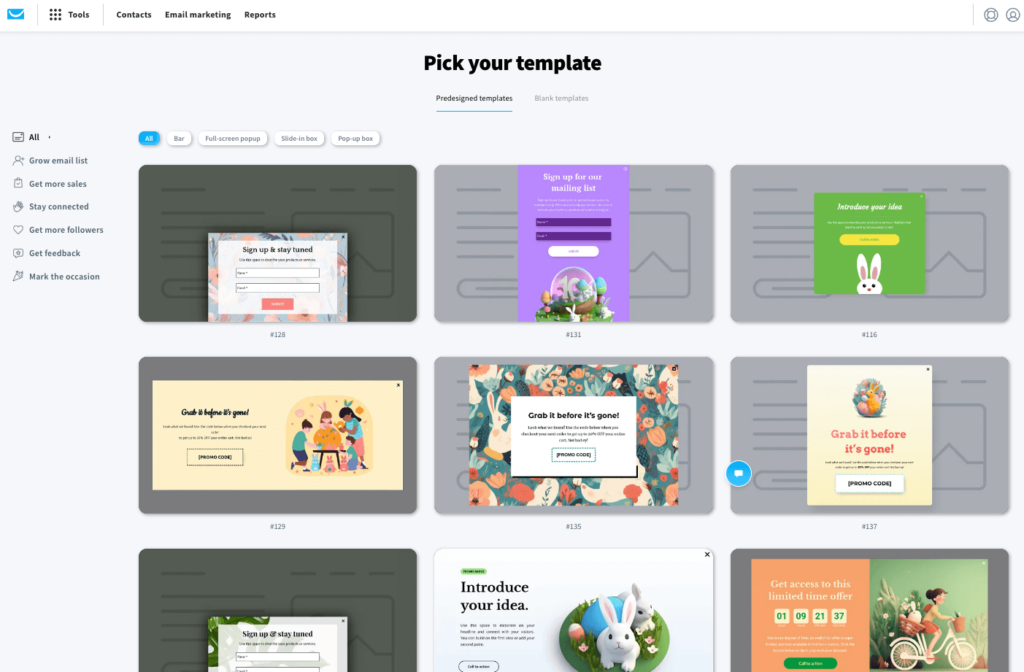
GetResponse signup form templates
There are also 150+ templates in GetResponse’s library, giving you endless options to try out.
GetResponse’s form builder is easy to navigate, and you can customize your templates easily. The only downside is that the form templates are not copy-ready.
tinyEmail’s form builder, on the other hand, is a bit limiting, and we found it a little difficult to customize forms. You’d also need to add forms manually to your website source as it doesn’t launch automatically.
Another difference between GetResponse vs tinyEmail in terms of list building is that tinyEmail doesn’t provide landing pages. GetResponse provides landing pages and 200+ decent landing page templates.
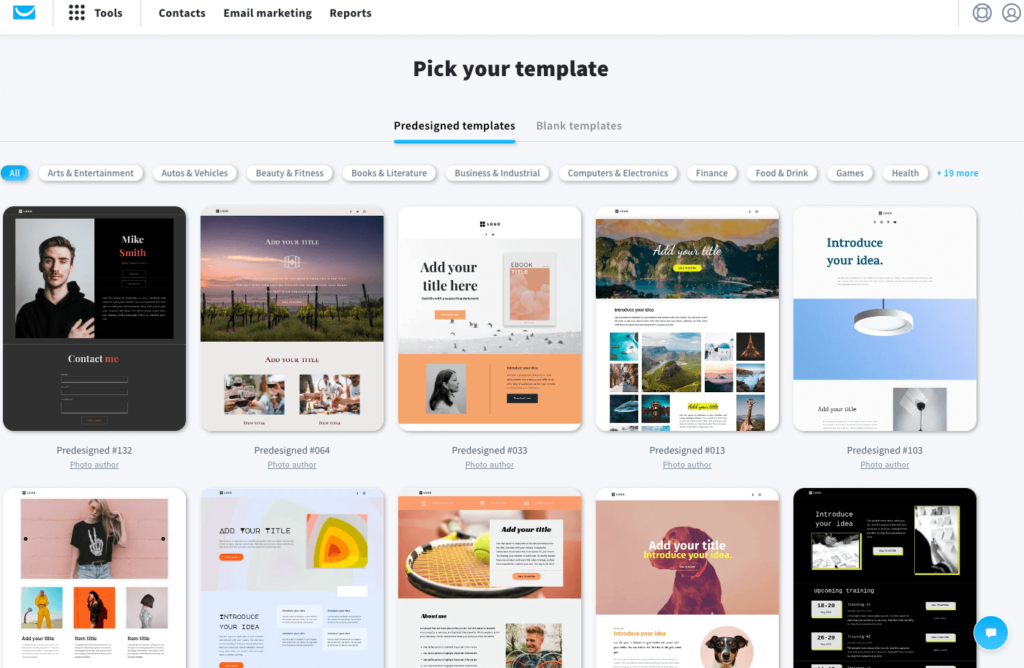
GetResponse landing page tenplates
There’s also a landing page builder that uses the drag-and-drop technique to help customize your templates and the AI landing page generator.
The platform lets you publish your landing page using your own domain or under GetResponse’s free domains.
As for signup form statistics, tinyEmail doesn’t offer any. GetResponse, on the other hand, lets you view click-through rates, clicks, subscriptions, leads, and more, by location, device, etc.
List management
Managing email lists is easy on both platforms. You can easily group your contacts into lists (which tinyEmail calls Audiences), upload contacts manually, etc. However, GetResponse provides more insights into your audience.
GetResponse takes the lead. It provides a detailed signup form and landing page features while tinyEmail needs the landing page feature and overall is more simple and limited than GetResponse.
Segmentation
We found the segmentation feature on tinyEmail to be pretty simple compared to GetResponse’s advanced segmentation options.
For instance, you can only segment your audience based on email engagement activities (i.e. clicks, opens, etc.) and subscriber profile information (e.g. name, location order count, etc.).
GetResponse provides more segmentation options, such as:
- Contact actions
- Geolocation
- Contact details
- Leads magnet
- Consent fields
- Conversion funnel
- Ecommerce behavior
- Scoring tags
GetResponse doesn’t provide prebuilt segments while tinyEmail does. tinyEmail provides 15 prebuilt segments that are helpful for beginners.
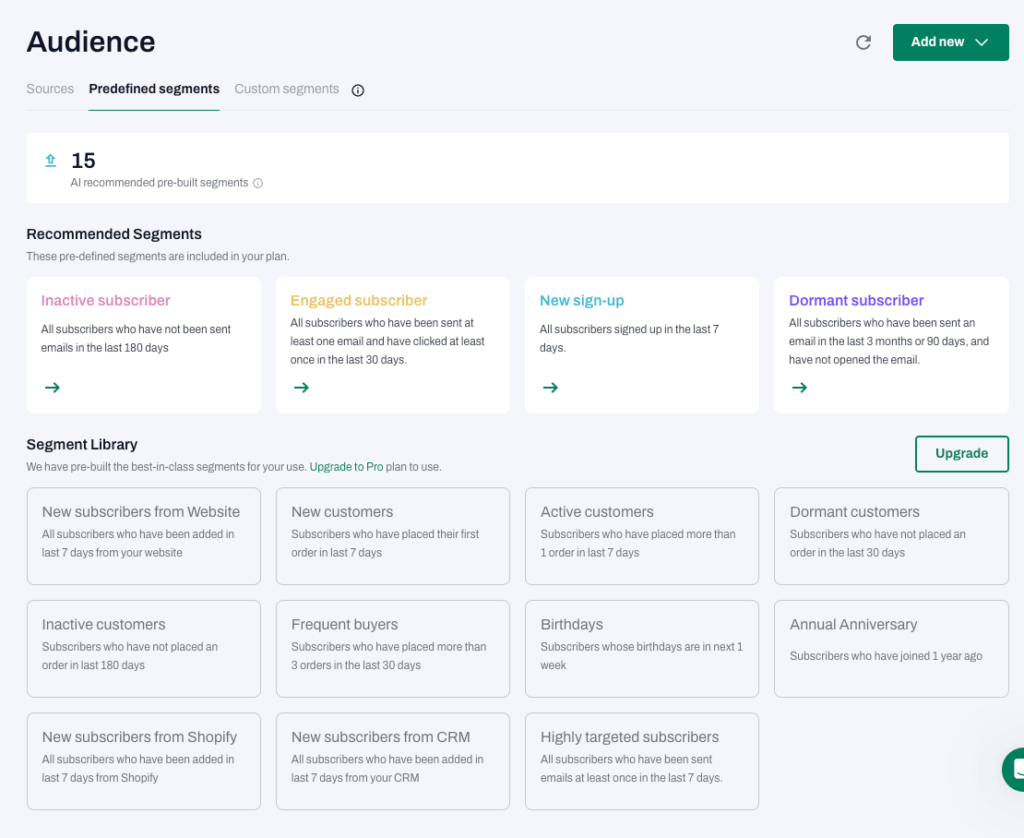
tinyEmail segmentation library
However, only four segments are available with the lowest-tier plan. The rest are only for the higher-tier plan users. And no segmentation is available with the free plan.
While GetResponse’s segmentation is detailed enough for most users, we didn’t find the criteria to segment audiences by onsite behavior.
GetResponse wins for having a more robust segmentation feature. In this regard, tinyEmail might be sufficient only for the very business beginners.
Analytics
With tinyEmail, you can track all the standard email marketing metrics, including email activity reports, campaign performance, and sales reports for users on the Shopify platform.
Compared to GetResponse, however, these reports seem pretty basic. GetResponse tracks a wide range of metrics and provides in-depth reports. Here are some examples:
- A/B test reports: You can track metrics from testing landing pages, email subject lines, CTAs, email layouts, and more.
- Ecommerce performance: These include reports related to your online store’s revenue, average order value, customer order history, and product recommendations.
- Subscription metrics: These include subscription rates, subscription methods, list growth trends, and more.
- Click maps: These help you focus on how users click on your emails to determine where they focus their attention the most.
The one downside to GetResponse’s analytics, however, is that its ecommerce reports are only available with the higher-tier plans.
GetResponse takes the lead as it provides more detailed reports and analytics.
Customer support
GetResponse provides 24/7 customer support, but the level of support varies depending on the plan you’re on. Here are the details:
- Free plan: No customer support
- Email marketing, Marketing Automation, and Ecommerce Marketing plans: 24/7 email and chat support
- MAX2 plan: All the above plus phone support, Slack support for select customers, and a dedicated customer experience manager.
tinyEmail provides 24/7 email and chat support to customers on all plans including the free plan. Users on the Pro and Enterprise plans also get priority support.
We also found it quite helpful that tinyEmail offers an onboarding call.
Both tools provide DIY resources such as a blog and a Help Center, but GetResponse’s resources are more comprehensive. They include:
- Video tutorials and infographics
- A webinar library
- Case studies
It’s a tie. GetResponse and tinyEmail offer 24/7 customer support and multiple online resources.
Integrations
Both tinyEmail and GetResponse provide useful integrations that users can take advantage of. These include integrations with ecommerce platforms like Shopify, WooCommerce, and Magento.
tinyEmail allows you to migrate easily from other email marketing platforms like Mailchimp, Drip, Campaign Monitor, and Constant Contact. You’ll get integrations with popular platforms like QuickBooks, Zoho, HubSpot, Salesforce, Stripe, OptinMonster, etc.
Get Response also integrates with 100+ popular business applications, such as:
- CRM tools like Zoho CRM
- Payment software like Paypal and Stripe
- Social media tools like YouTube
- Ad and conversion tools like Google Ads
Both tools seem to have a sizeable list of useful integrations. However, GetResponse has them more.
Compatibility with other marketing channels
GetResponse is compatible with various marketing channels, such as:
- SMS (only available for MAX plan users)
- Push notifications
- Facebook pixel
- Google ads
- Facebook ads
tinyEmail doesn’t provide any other marketing channels besides email at the moment.
GetResponse is the clear winner in this round.
Generative AI tools
Generative AI tools help customers save time creating email subject lines and content from scratch.
All you’ll need to do is specify your keywords, provide context like the goal and tone of your email, then customize the generated email and send it to your recipients.
Both tinyEmail and GetResponse provide their own versions of these AI tools.
tinyEmail has one called tinyAlbert.
This generative AI tool helps Shopify businesses generate compelling subject line suggestions, email content suggestions, theme content, etc. The feature uses GPT-4 AI technology to do all your email marketing for you.
GetResponse has two tools:
- AI email generator: This allows you to generate email subject lines and content using AI.
- AI recommendations: This allows you to personalize your ecommerce website’s shopping experience by generating self-adapting product recommendations for customers based on their shopping activity.
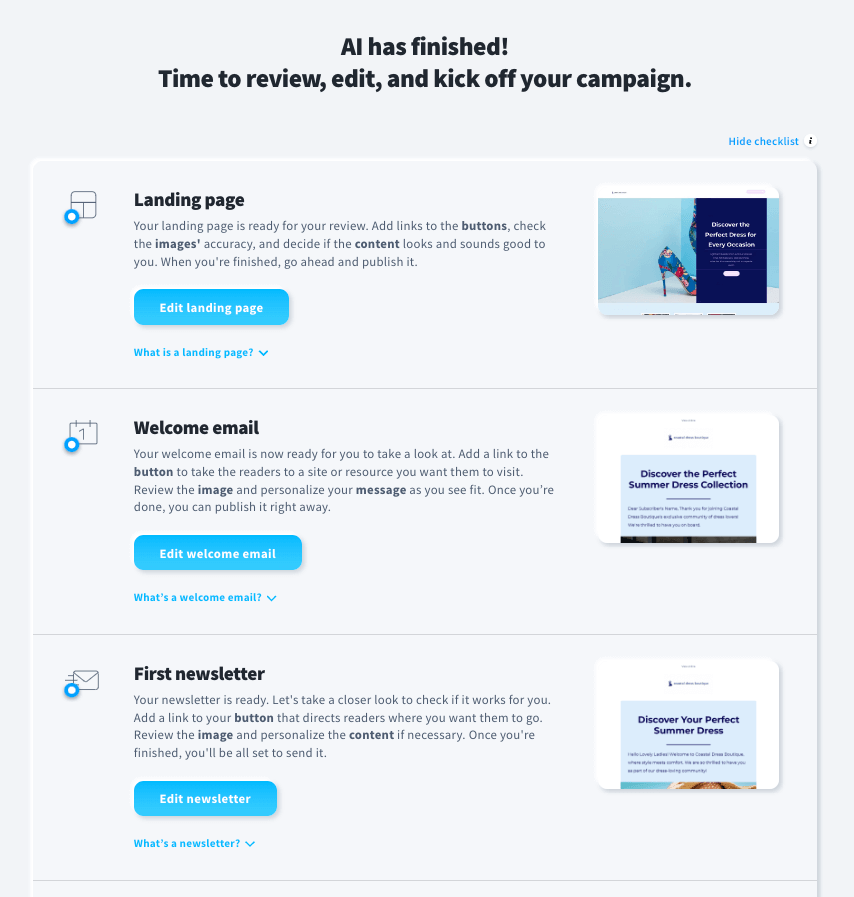
GetResponse AI generated creatives
GetResponse wins as tinyEmail’s AI tool is limited to Shopify users.
Price Comparison
tinyEmail vs GetResponse: which tool gives you the most value for your money? Let’s find out by checking out all the plans they offer and comparing them.
Free plans
Both GetResponse and tinyEmail offer free plans. Here are some features you’ll get with tinyEmail’s free plan:
- Send up to 15,000 emails per month
- Up to 500 subscribers
- Forms and popups
- Automation emails
- AI subject line assistant
- Limited sender identities
- Limited email templates
For segmentation, custom domain and full library of email templates you will be asked to sign up for a paid plan.
In addition, tinyEmail offers a new Shopify Pro plan for Shopify users. It’s free of charge and includes paid features. This offers gives you a perfect chance to try the platform out.
GetResponse’s free plan provides the following features:
- 25000 emails per month
- Up to 500 contacts
- Website builder plus 5GB bandwidth
- Landing pages and signup forms but no popups
- Connect a domain
On GetResponse, ecommerce reporting and ecommerce features, popups, automation workflows, autoresponder series and score tracking is available for paying customer only.
Although limited, these free plans are great for businesses just starting out and looking to fulfill basic email marketing needs. They’re also a great way to test out either platform before making any financial commitment.
Paid plans
GetResponse’s pricing plans are based on the number of subscribers in your contact list while tinyEmail’s prices are based on the number of emails sent.
GetResponse provides four paid plans including:
- Email Marketing
- Marketing Automation
- Ecommerce Marketing
- GetResponse MAX
tinyEmail has three paid plans—Standard, Pro, and Enterprise.
tinyEmail allows you to have unlimited contacts as long as you stick to sending a specific number of emails per month. This could be cheaper for businesses with large email lists compared to contact-based pricing.
Contact-based pricing, such as the one offered by GetResponse, tends to get expensive quickly as your subscriber list grows.
Overall, tinyEmail is a much cheaper tool compared to GetResponse. But this is because it offers fewer, simpler features. So, as far as value for money is concerned, both tools seem to hold their own.
The only downside to GetResponse is that most of its vital ecommerce features, such as cart abandonment automation and ecommerce tracking, are only available with the higher-tier plans.
So even though the lower-tier plans are relatively cheaper than other email marketing tools out there, their features are just as limited.
tinyEmail vs GetResponse: which one wins?
So which tool is ideal for your business, tinyEmail or GetResponse? Ultimately, the best tool for you will depend on your business needs.
Before announcing a winner, here’s a quick recap comparing these two platforms’ pros, cons, prices, and features side by side.
3.5
4.6
Up to 15,000 emails – $15
Up to 25,000 emails – $25
Up to 50,000 emails – $50
Up to 100,000 emails – $100
1,000 subscribers – $19
5,000 subscribers – $54
10,000 subscribers – $79
50,000 subscribers – $299
100,000 subscribers – $539
- Up to 500 subscribers
- Up to 15,000 emails per month
- Forms and popups
- Automation emails
- AI subject line assistant
- Limited sender identities
- 2,500 email sends /month
- Basic email campaign tracking
- Email templates
- Very basic segmentation
- Signup forms but no popups
Pros:
- Easy to sign up and use
- Good email builder
- An extensive list of email templates
Cons:
- Basic automation and reporting
- Pretty basic segmentation
- Form builder should be improved
Pros:
- Very complete tool with lots of features
- Affordable pricing
- Easy to use
Cons:
- Might be a bit overwhelming for beginners
- Ecommerce features are only available in the highest-tier plans
- Small ecommerce businesses
- Email marketing beginners
- Bloggers
- Non-profit organizations
- Small and medium-sized ecommerce businesses
- Established ecommerce businesses
- Complete email marketing beginners
- Solopreneurs
- Non-profit organizations
- Bloggers
From the above review, you can tell that tinyEmail is a simple email marketing tool that’s ideal for small businesses, bloggers, small ecommerce stores, and email marketing beginners.
It’s an affordable, easy-to-use platform to get you started with your list-building needs and email marketing campaigns.
GetResponse, on the other hand, is more advanced and has a wider range of features and functionalities.
This makes it much more suitable for established businesses, medium-sized ecommerce stores, and experienced marketers.
However, if you’re an ecommerce store looking for a more specialized tool, you may want to consider other options, such as Omnisend. This is especially so if you’re a growing business looking for an affordable tool.
This is because tinyEmail has very limited ecommerce features and GetResponse’s ecommerce features are only available with the higher-tier plans, which can be expensive.
So, go ahead and choose the tool that suits you best. Good luck!
Read full reviews
Related picks for you
Our team strives to be accurate and unbiased in reviewing email tools. However, we recognize that mistakes can happen, and it’s essential for us to stay up to date. If you come across any errors or things that need to be reviewed again, please let us know.





Leave a Reply